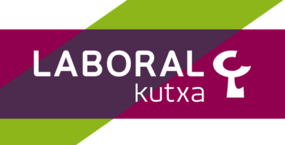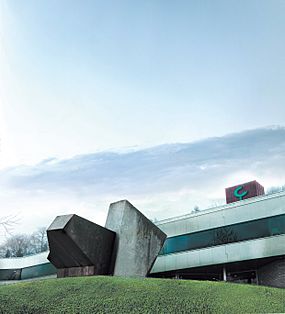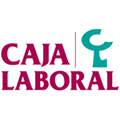Laboral Kutxa facts for kids
 |
|

Laboral Kutxa Central Office
|
|
| Industry | Financial services |
|---|---|
| Predecessor | Caja Laboral, Ipar Kutxa |
| Founded | 2012 |
| Headquarters | Pº José María Arizmediarrieta s/n, 20500, Mondragón, Spain
|
|
Number of locations
|
380 |
|
Key people
|
|
| Products | Retail, corporate, investment banking and private banking, insurance, asset management, private equity |
| 36.7 million euros (2013 First Quarter) | |
| Total assets | 24,400 million euros |
|
Number of employees
|
2,235 |
Laboral Kutxa is a special kind of bank called a credit union in the Basque Country, Spain. It was formed in March 2012 when two other credit unions, Caja Laboral and Ipar Kutxa, joined together. This merger helped them become a stronger financial group. The new company was officially introduced in April 2013.
Contents
History of Laboral Kutxa
Caja Laboral: A Helping Hand
Caja Laboral, also known as Euskadiko Kutxa, was started in 1959. It was founded by José María Arizmendiarrieta, a Catholic priest. He came to the town of Mondragón in 1943. He helped create a technical college and several co-operatives. Co-operatives are businesses owned and run by their members, who share the profits or benefits.
These co-operatives included ULGOR (now Fagor), Funcor (now Fagor Ederlan), Arrasate (now Fagor Arrasate), and the San Jose Consumer's Cooperative (now Eroski). These were the first parts of what is now the Mondragon Corporation. Arizmendiarrieta planned for Caja Laboral to be the financial support for these co-ops.
Caja Laboral was very important for the Mondragon Corporation as it grew. For 50 years, its "Companies Division" helped new co-operatives get started. In the 1970s, the credit union gave special loans to co-ops that were struggling. This was during a tough time for the Basque industry, with high unemployment. Caja Laboral's saying then was "libreta o maleta." This meant that being part of the union ("libreta" or savings book) was a way to avoid having to leave home for work ("maleta" or suitcase).
Caja Laboral was also a worker's co-operative. This meant its employees could help make decisions and share in the company's profits. Before it merged with Ipar Kutxa, Caja Laboral had many employees, clients, and offices. It was also the first financial group in Europe to win a special award for good management.
Ipar Kutxa: Growing in the North
Ipar Kutxa started in 1965 as "Caja Rural Provincial de Vizcaya." It was mainly founded by two co-operatives: Beyena, a dairy co-op, and Uteco, a farmers' co-op.
In 1980, the union changed its name. Six years later, it avoided serious financial trouble with help from the Bank of Spain. It then became "Caja Rural Vasca" (or "Baserritarren Kutxa" in Basque) and began to grow outside the Biscay area.
In 1997, it changed its name slightly again. In 2003, it opened its first offices in Gipuzkoa and officially became Ipar Kutxa. "Ipar Kutxa" means "union of the North" in Basque.
When it joined with Caja Laboral, Ipar Kutxa had many assets, offices, clients, and workers.
Joining Forces: The Merging Process
In March 2012, Caja Laboral and Ipar Kutxa announced they would merge. Their goal was to create a stronger financial group. They wanted to offer a different way of banking compared to other banks in Spain. The new combined company would become the largest credit union and the third-largest financial group in the Basque Country. It would also be the second-biggest credit union in all of Spain.
The merger happened step by step. Between March and November 2012, clients could do business between the two companies for free. Their computer systems were combined, and some older workers were offered early retirement. The merger was finished on November 1, 2012. The new company kept the name Caja Laboral – Euskadiko Kutxa until June 2013. Then, it announced its new name: Laboral Kutxa.
Laboral Kutxa Today: Facts and Figures
Laboral Kutxa is the biggest credit union in the Basque Country. It is also the third largest in Spain. It serves about 750,000 clients in the Basque Country and another 110,000 in Navarre, making a total of over 1.3 million clients.
The company currently has about 2,500 employees. It manages a lot of money, with assets worth 24.564 billion euros. Assets are like all the valuable things the company owns.
How Laboral Kutxa is Managed
Just like Caja Laboral and Ipar Kutxa before it, Laboral Kutxa is a worker's co-operative. This means it follows special Spanish laws for co-operatives. It must pay attention to the needs of its own workers.
All workers at Laboral Kutxa are members of the company. They get to vote in the General Assembly, which is like a big meeting where important decisions are made. Clients who are very involved with the union can also become members if they want to. In February 2013, Laboral Kutxa allowed clients to become members with a small contribution.
The main leaders of Laboral Kutxa are:
- President: Txomin García
- Chief executive officer: Xabier Eguibar
Where You Can Find Laboral Kutxa Offices
Laboral Kutxa has about 400 offices. You can find them in the Basque Country, Navarre, Aragón, La Rioja, Castile and León, Cantabria, Asturias, and Madrid.
Marketing and Colors
For many years, Caja Laboral used the
symbol of a key for its brand. Ipar Kutxa didn't have a special image, just its name. When they merged, Laboral Kutxa used colors from both old companies: deep red and lime green. These colors are now very noticeable in the company's logo, its offices, and all its advertisements.
Images for kids
See also
 In Spanish: Laboral Kutxa para niños
In Spanish: Laboral Kutxa para niños


